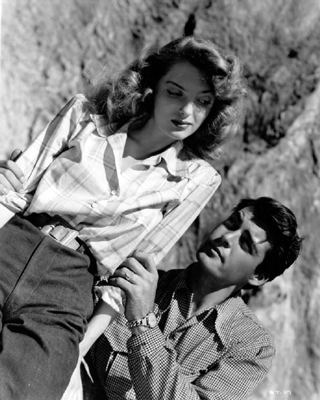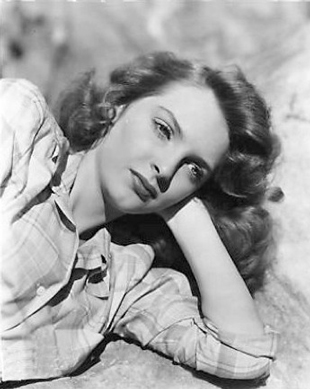
 |
|
|
|
The crows in Dumbo might have been predicting a major theme for the 1940s when they prescribed a new approach to problem solving: "Cology! You know, Psy - cology!" Psychiatry, psychology and related mental manias were made a factor in thrillers, domestic dramas, even westerns. And as film noir favored characters suffering from angst, alienation and repressive guilt, the theme invaded that style as well. 
1947's The Red House was concocted by the successful Warners writer-director Delmer Daves. He had adapted The Petrified Forest and wrote the screenplay for Love Affair. His other 1940s efforts include the attempted stream-of-consciousness noir Dark Passage and socially conscious movies about the problems of veterans, The Very Thought of You and Pride of the Marines. Made for independent producer Sol Lesser and released through United Artists, The Red House was adapted from a Saturday Evening Post story, like the noir Gun Crazy and many other movies of the day. Daves put the psychological angle front and center in a tale that plays as a slightly daft mix of rural Americana and haunted house ideas, with hints of a Production Code taboo thrown in for good measure. Heading the strong cast is Edward G. Robinson, doing his darnedest to put across a difficult-to-believe premise. Honest teen Nath Storm (Lon McCallister) has a clinging, manipulative girlfriend in Tibby (Julie London) but accepts an after-school job offered by another girl, Meg (Allene Roberts). Meg's adoptive father Pete Morgan is finding it difficult running his farm with a bad leg, and needs help with chores. Meg and Nath couldn't be happier, but Pete becomes angry, emotional and evasive when Nath insists on taking a detour through a remote patch of woods. Pete tires to scare the boy with allusions to screaming and unnamed terrors in the woods, but the level headed Nath pays no attention. Something in the dark clubs Nath on the head, making the boy determined to get to the bottom of the mystery. Pete is even more distraught when Meg defies his authority and aligns with Nath. She gets no help from Pete's sister Ellen (Judith Anderson), who seems overly protective of her brother's past. Tibby is also involved, as she's trying to play off Nath against a handsome local fellow, Teller (Rory Calhoun). The unreliable Tibby betrays Nath's confidence and forms a risky relationship with Teller, a shifty fellow who seems to have some kind of deal going with Pete. Eventually both Nath and Meg set out to find the secret in the woods -- while Pete warns them that their curiosity could be deadly. The Red House is an intense, somewhat off-kilter suspense story that promises a dangerous secret and delivers a decidedly "unhealthy" revelation. Meg is sweet and polite to a fault, an adorable innocent who finds out that becoming an adult means learning about unpleasant realities. Nath Storm is almost too virtuous to be true. A friendly take-charge kind of guy, we see him ignoring Tibby's excessive demands for attention. He even directs his mother's love life. Mrs. Storm (Ona Munson of The Shanghai Gesture) hasn't remarried out of respect for Nath (?), so he encourages her to go see that nice fellow who's been after her for years, Don Brent (Walter Sande). Nath is conscientiously honest with Pete, but flat-out refuses to pay attention to his demands and pleas not to take the short cut through the forest. 
And right there is the main problem with the story. Anyone would realize within five minutes that Pete Morgan is as crazy as a loon and desperately hiding some guilty secret in the woods. I suppose there are plenty of rural hollows out there in America where any number of family secrets could be stashed away, but the only film to really play up the innocent/horrible angle in hometown Americana is David Lynch's Blue Velvet. The advertising misleads us into thinking that the Red House is a large building, perhaps a "house of ill repute". The film's tagline boasts "You Dare Not Even Guess The Strange Love Story Of The Red House", but enough clues are given in the film's first few minutes to allow anybody to hit it on the nose. But those drawbacks are not what we remember about The Red House, which builds a powerful sympathy for its young characters. It also lends a truly weird atmosphere to what otherwise might be innocuous scenes. Bert Glennon's cinematography lays on the chiaroscuro shadows. Nath's first trip into the "bad" patch of woods has an uneasy feeling that few haunted house movies attain. Although we're fairly sure that nothing supernatural is afoot, the sense of dread is definitely a factor. At one point Meg is challenged by Pete while swimming. She holds onto the dock, appearing incredibly vulnerable as she stares up, wet and shivering. I don't remember Robinson ever giving a bad performance, and he's quite good as the haunted & guilty Pete. Director Daves ends too many scenes with him staring in inner confusion. Sealing the deal is Miklós Rózsa's musical score. After Spellbound Rózsa was asked to use Samuel Hoffman's eerie theremin so much that he finally swore off the use of the electronic instrument. Here it's put to excellent, subtle use. When Meg ventures into an unknown part of the forest, she's hit by a strange feeling that she's been there before. Her dialogue is almost unnecessary as she searching eyes and the theremin tip us off. Classic Hollywood film music fans will feel their own twinge of Déjà vu when they finally hear this score -- a 12-minute The Red House suite was featured on one of the earliest Charles Gerhardt re-recording compendiums from the 1970s. 1 It would be a real spoiler to go further into the plot, and to discuss the film's tall stack of undigested details, especially with the Rory Calhoun character. But here are some lingering thoughts: Pete Morgan has a bad habit of doing something terrible, and then blaming others for it. We don't know if he's just maladjusted, or a dangerous sociopath. Judith Anderson's Ellen character is played as "protective", but also comes off as criminally irresponsible. She knows the score, realizes that the young folk are in danger, and chooses to act passive out of concern for her brother Pete. I say lock her up too. As a generational struggle between screwed-up older folks and good teenagers, this show bears comparison with Daves' later A Summer Place. As for the big social Taboo, the theme here is almost the same as in (I kid you not) Forbidden Planet, where a lot of murders take place because a man can't bear to part with a daughter figure. Robinson's Pete also confuses (scrambles?) Meg's identity in the same way that James Stewart is tricked/brainwashes himself in Vertigo. 
Finally, Julie London is to die for ... this is the youngest I've seen her. She never showed "A" acting ability but she's a wise choice to use as poster bait. The attractive Allene Roberts reminds me a bit of Elizabeth Perkins, for some reason. Unable to find good scene stills for The Red House, I've opted to go for some nice angles on the two leading ladies. HD Cinema Classics found an excellent print for their Blu-ray of The Red House, besting their earlier BD releases of the Public Domain attractions Dementia 13 and The Terror. The contrast range is quite good, as is sharpness; digital cleanup helps as well. A few odd artifacts show up in the lower corner of the frame, but only in dark areas and only if one really looks for them. A restoration specialist I watched the disc with spotted them, not me. Some Day-for Night scenes are timed rather brightly, but I've not seen an original print to compare. The audio track is quite good if not 100% clear. The source was likely a positive print as well. What needs to be stressed is that The Red House has been a Public Domain eyesore for decades, ever since original 16mm prints stopped being broadcast on television. After seeing smeary, spliced opening titles for this thing several times, I've skipped trying to watch it until now. I didn't even know that Julie London was in the movie. The wait was worth it. If HD Classics continues to pick and choose those PD shows that it can bring to this level of BD quality, they'll have my endorsement. Is this Blu-ray going to compete quality-wise with a new movie? No. But a look at the price confirms the value given, especially considering what some companies charge for indifferent DVD pressings. Besides a second standard DVD copy -- more useful than you'd think -- the film comes with an audio commentary by noir film critic William Hare, a mail-able (remember mail?) postcard, a restoration demo and a video promo that pretends it's an original trailer.
On a scale of Excellent, Good, Fair, and Poor,
The Red House Blu-ray rates:
Footnotes
1. It's a weird feeling, seeing something like The Constant Nymph after enjoying its music for 35 years. Sometimes you feel like you know what will happen next, because you unconsciously know where the music is going.
Reviews on the Savant main site have additional credits information and are often updated and annotated with reader input and graphics. Also, don't forget the 2011 Savant Wish List. T'was Ever Thus.
Review Staff | About DVD Talk | Newsletter Subscribe | Join DVD Talk Forum |
| ||||||||||||||||||